From the Palaeolithic to the pre-Roman period
The Neanderthal Man in Sanremo
The eclecticism of its imposing historical buildings, its greenery, the flower-growing and tourism industries, the old town of "Pigna", the multitude of buildings built from the post-war years onwards and above all its history, make Sanremo a modern town but one of a particular uniqueness.
Speaking of History, the one that is commonly known the most is the one that, starting from the early '800 arrives until the most recent days.  Not everybody knows it, instead, talking about the population, more than the town itself, which has a history that goes back to the Palaeolithic period.
Not everybody knows it, instead, talking about the population, more than the town itself, which has a history that goes back to the Palaeolithic period.
We understand perfectly that what we are about to tell, not to everyone can be understandable, but we will try in every way to make the reading as smooth as possible and to highlight the terms men or known with external hooks, highlighted in blue.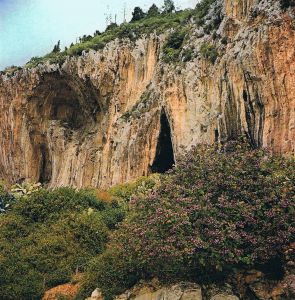 A series of archaeological discoveries, which have taken place over the years, although we know that along the coast there are caves in which the finds found date back 950 thousand years (like those of the Balzi Rossi), those found in the Sanremo area can be dated no more than 100 thousand years. In any case, a respectable seniority, brings us back to the Upper Palaeolithic, at the beginning of the last Quaternary glaciation.
A series of archaeological discoveries, which have taken place over the years, although we know that along the coast there are caves in which the finds found date back 950 thousand years (like those of the Balzi Rossi), those found in the Sanremo area can be dated no more than 100 thousand years. In any case, a respectable seniority, brings us back to the Upper Palaeolithic, at the beginning of the last Quaternary glaciation. The bands of prehistoric hunters who frequented the Ligurian coast at that time were formed by individuals with well-defined physical characteristics: medium stature, strong skull, peculiar skull of the Homo Sapiens Neanderthalensis, commonly known as the Neanderthal Man.
The bands of prehistoric hunters who frequented the Ligurian coast at that time were formed by individuals with well-defined physical characteristics: medium stature, strong skull, peculiar skull of the Homo Sapiens Neanderthalensis, commonly known as the Neanderthal Man.
These men with a heavy bearing, archaic face and in some aspects still animal, yet endowed with a certain intelligence, were preceded in time by individuals belonging to the Homo erectus strain, later evolved in the Neanderthal; the Neanderthalians concluded their very long evolution about 80,000 years ago.
Human traces belonging to the latter came to light in the lower layer of the cave of the Madonna dell'Arma di Bussana where, in the 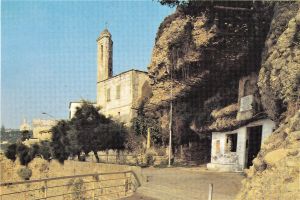 seventeenth century, the suggestive rock sanctuary of the Annunziata was built. Behind the apse of the church, a tunnel 6 to 10 metres wide, dug in the Pliocene conglomerate of the promontory overlooked by the tower of 1565, continues for about 40 metres, where, however, a landslide prevents its continuation. Quaternary sediments can be observed on the eastern side of it (which can also be found along the beach below).
seventeenth century, the suggestive rock sanctuary of the Annunziata was built. Behind the apse of the church, a tunnel 6 to 10 metres wide, dug in the Pliocene conglomerate of the promontory overlooked by the tower of 1565, continues for about 40 metres, where, however, a landslide prevents its continuation. Quaternary sediments can be observed on the eastern side of it (which can also be found along the beach below). 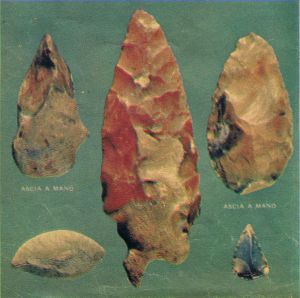 This conglomerate promontory, which can still be seen today, has reserved many archaeological surprises during the excavations that have been carried out.
This conglomerate promontory, which can still be seen today, has reserved many archaeological surprises during the excavations that have been carried out.
The beach in front of it, the result of interglacial erosions (95 000 ± 5000 years from today, according to a radiometric dating), was rich in characteristic shells and some archaic lithic quartzite tools: a scraper and the part of a large splinter typical of the archaic Mousterian, together with some bone fragments.
The deposit above, formed by layers of sand, covers the millennia of the glacial phase, up to about 60,000 years ago, and stone tools were also found here.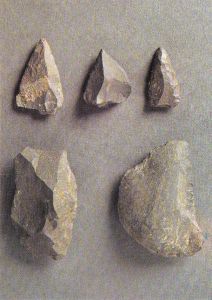 also dating back to the typical Mousterian, rich in scrapers, with progressive presence of artefacts, obtained with a technique that allowed to predetermine the shape at the time of manufacture. In addition to scrapers, there are also toothpickers, while there are few burins and perforators; among the knives there is a characteristic shape with a single blade that distinguishes the deposit of via San Francesco (today via M. C. Astraldi) in the
also dating back to the typical Mousterian, rich in scrapers, with progressive presence of artefacts, obtained with a technique that allowed to predetermine the shape at the time of manufacture. In addition to scrapers, there are also toothpickers, while there are few burins and perforators; among the knives there is a characteristic shape with a single blade that distinguishes the deposit of via San Francesco (today via M. C. Astraldi) in the  centre of San Remo. The fossil remains of fauna include above all the royal deer, followed in order of abundance by aurochs, cave bears, wild boar, hyena, Merck's rhinoceros, hippopotamus, ancient elephant, horse. On the basis of the collected elements, we can imagine an initial climate tending to cold and progressively humid, with vegetation formed by pinewoods and oak woods; the presence of the hippopotamus may depend on the marshy environment of the mouths of Armea and Argentina, close to the cave.
centre of San Remo. The fossil remains of fauna include above all the royal deer, followed in order of abundance by aurochs, cave bears, wild boar, hyena, Merck's rhinoceros, hippopotamus, ancient elephant, horse. On the basis of the collected elements, we can imagine an initial climate tending to cold and progressively humid, with vegetation formed by pinewoods and oak woods; the presence of the hippopotamus may depend on the marshy environment of the mouths of Armea and Argentina, close to the cave.
The locality continued to be frequented by prehistoric man even after the glaciations, but the obstruction deposit that closed the cave and that contains the finds still hides some secrets.
Between 39 000 and 35 000 years from today, there was a period of dry and intensely cold climate, with pine and birch vegetation, and while in the rest of Europe the Neanderthalians and the Mousterian industry were shrinking, in Liguria instead, thanks to the relatively mild climate, they were still present and active. Along the steep eastern side, 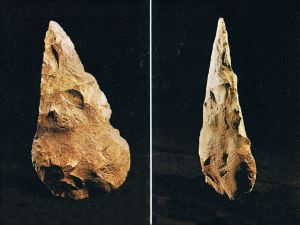 above the San Francesco torrent just at the height of its last bend, at a height of about 18 metres, there was a shelter or an open-air meeting point frequented by
above the San Francesco torrent just at the height of its last bend, at a height of about 18 metres, there was a shelter or an open-air meeting point frequented by 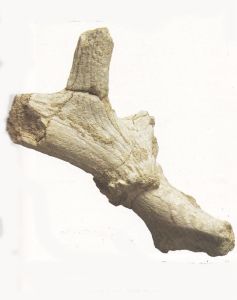 groups of hunters. Thanks to a building excavation in 1960 it was possible to recover over 3000 artefacts in quartzite and local grey-blue limestone and remains of fauna, especially royal deer.
groups of hunters. Thanks to a building excavation in 1960 it was possible to recover over 3000 artefacts in quartzite and local grey-blue limestone and remains of fauna, especially royal deer.
Naturally, these finds have attracted the attention of scholars, because the Paleolithic deposit in Via San Francesco represents, as Giuseppe Vicino, Conservator of the Museo Civico di Finale, wrote, "the expression of the maximum evolution reached by Musterian lithotechnics at the end of the cycle they represented". In fact, only two deposits of the same type are known. The dating of the deposit has not been completely defined, with debate between the Lower and Upper Palaeolithic periods. The collection of the instruments found is unique in the panorama of the Ligurian Mousterian of lithic 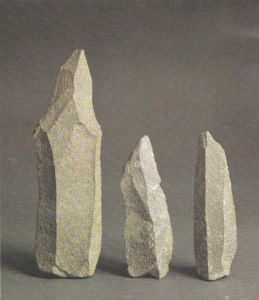 splinters. The list is diversified, there are splinters that have not yet been transformed into tools, with long and thin blades, almost never retouched, abundant toothbrushes, scarce scrapers and tips, numerous back knives, of the "San Remo type", with one of the edges knocked down for a short stretch near the tip and of considerable length, with specimens of over 20 cm. The game is mainly represented by royal deer, then by horses, roe deer and rhinoceroses.
splinters. The list is diversified, there are splinters that have not yet been transformed into tools, with long and thin blades, almost never retouched, abundant toothbrushes, scarce scrapers and tips, numerous back knives, of the "San Remo type", with one of the edges knocked down for a short stretch near the tip and of considerable length, with specimens of over 20 cm. The game is mainly represented by royal deer, then by horses, roe deer and rhinoceroses.
From the presence of numerous deer antlers, fallen to the animals for the annual moulting and collected by man, it can be deduced that the sheltered place was frequented by hunters still at the end of winter. The place was probably inhabited for short periods, but the discovery of similar finds at a short distance suggests a larger camp.
The Middle Palaeolithic and Mousterian periods have, in the territory of Sanremo, significant examples of great originality at the beginning and at the end of the period, confirming that the area must have been regularly inhabited or travelled by human groups, even if the traces that have come to light so far offer only partial and episodic information.
From nomads to settled and then warriors
Around Sanremo there are some mountains that after centuries of silence, have revealed their mysteries concerning the hunting or pastoral activities of primordial man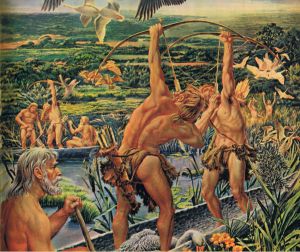
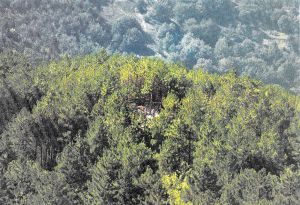 With the end of the Würmiana glaciation (see) and therefore with a progressively milder climate, Paleolithic man first limited himself to collecting shellfish and wild fruit, then, using the recent discovery of bows and arrows, he began hunting small animals, since the larger ones had retreated following the melting of the glaciers.
With the end of the Würmiana glaciation (see) and therefore with a progressively milder climate, Paleolithic man first limited himself to collecting shellfish and wild fruit, then, using the recent discovery of bows and arrows, he began hunting small animals, since the larger ones had retreated following the melting of the glaciers.
The most sought-after prey remained the deer, wild boar, ibex, as well as smaller game and birds. Seasonally, groups of hunters would gather in bivouacs right near the places from where the wild animals to hunt were certain to pass. The arrowheads were small flint artefacts with a triangular or rhombus shape or other geometric shapes.
Between about 7000 and 6000 years B.C., bivouacs of Mesolithic hunters, in the presence of a new dry and hot climate, came to settle along the coast (La Mortola di Ventimiglia), on the inland mountains (San Giovanni dei Prati, near Triora) and at the foot of Mount Bignone, on a hilltop of the locality Pian del Re, just beyond the pass of Termini di Baiardo. The microlytic instruments collected here, especially in the shape of a trapeze, indicate that the stops did not have to be prolonged, but that they were repeated regularly in a very large area.  As time went by, people gradually abandoned nomadic life, creating a more stable society made up of villages, dedicated to agriculture, the manufacture of ceramics and in general the evolution of material and moral life.
As time went by, people gradually abandoned nomadic life, creating a more stable society made up of villages, dedicated to agriculture, the manufacture of ceramics and in general the evolution of material and moral life.  Evidence of all this, however, unfortunately has not been found in research around Sanremo. The regular trade with interchange with other populations, the improvement of agricultural techniques, the introduction of iron weapons, brought the society to evolve further creating also social classes, but forcing the transhumant shepherds to climb the mountains and inland valleys, moving away from the already more developed agricultural areas.
Evidence of all this, however, unfortunately has not been found in research around Sanremo. The regular trade with interchange with other populations, the improvement of agricultural techniques, the introduction of iron weapons, brought the society to evolve further creating also social classes, but forcing the transhumant shepherds to climb the mountains and inland valleys, moving away from the already more developed agricultural areas.
Many testimonies of that period were found in the highest parts of the Argentina and Nervia Valleys, near Sanremo. The finds collected belonged to small necropolises with burial taverns and funerary furnishings such as vases, personal ornaments, weapons and tools. An armilla (see) dating back to the end of the Bronze Age, decorated with geometric motifs, was found on the slopes of Monte Bignone. To confirm, together with other armillas found on the neighbouring mountains, equally decorated, that there were classes of warrior leaders who, because of their position, used to adorn themselves with a series of bracelets.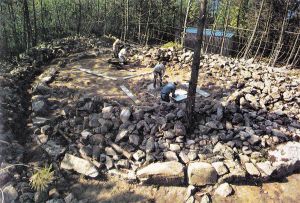 The most evident and exceptional confirmation from the point of view of the discovery, the prestige of the latter, is given by the burial mound necropolis of Pian del Re, hidden by vegetation and which was discovered only after a fire that struck the area about fifty years ago. On the hill once occupied by hunters' bivouacs, an enormous accumulation of circular shaped stones appeared, which could hide or a grandiose burial mound, confirmed as such by the archaeological excavations undertaken later. While other mounds of lesser importance were excavated in the following years, the largest, completely excavated one was imposing: more than 10 thousand stones, collected on site, a diameter of 14 metres surrounded by a wall formed by stones embedded in the ground. Inside there was a hypothetical funerary fence which measured only 4 x 2 metres. Around it were found fragments of urns dating back to the late Bronze Age, but also other objects or fragments of them much closer to us, such as a part of the neck of a late Roman amphora and a medieval Genoese coin. Being the first mound found in the whole of Liguria, the exact period could not be defined, but it is possible that it was between the late Bronze Age and the beginning of the Iron Age, between the 13th and 8th centuries BC.
The most evident and exceptional confirmation from the point of view of the discovery, the prestige of the latter, is given by the burial mound necropolis of Pian del Re, hidden by vegetation and which was discovered only after a fire that struck the area about fifty years ago. On the hill once occupied by hunters' bivouacs, an enormous accumulation of circular shaped stones appeared, which could hide or a grandiose burial mound, confirmed as such by the archaeological excavations undertaken later. While other mounds of lesser importance were excavated in the following years, the largest, completely excavated one was imposing: more than 10 thousand stones, collected on site, a diameter of 14 metres surrounded by a wall formed by stones embedded in the ground. Inside there was a hypothetical funerary fence which measured only 4 x 2 metres. Around it were found fragments of urns dating back to the late Bronze Age, but also other objects or fragments of them much closer to us, such as a part of the neck of a late Roman amphora and a medieval Genoese coin. Being the first mound found in the whole of Liguria, the exact period could not be defined, but it is possible that it was between the late Bronze Age and the beginning of the Iron Age, between the 13th and 8th centuries BC.
The exceptionality of the finding, in addition to its spectacularity, derives from the fact that nowhere else in northern Italy have similar findings been found, so a hypothesis tells us that they may have been brought by people from outside Italy.
However, only future excavations, after these important findings, will be able to answer questions that are still unanswered for the time being, especially concerning the most striking phenomenon of Sanremo's protohistory: the civilization of the castellarians.
Pre-Roman Ligurians and the "castellari"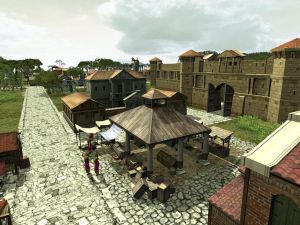 With the foundation of the Greek colony of Massalia (Marseille, at that time still a Ligurian territory) around 600 B.C., considerable changes took place because the expansion of the real eastern Greek trade and the arrival of new ethnic groups, caused the worsening of relations and conflicts between the coastal inhabitants, already more evolved, and the internal, agricultural and pastoral ones, changing the political-social structures and even the way of life.
With the foundation of the Greek colony of Massalia (Marseille, at that time still a Ligurian territory) around 600 B.C., considerable changes took place because the expansion of the real eastern Greek trade and the arrival of new ethnic groups, caused the worsening of relations and conflicts between the coastal inhabitants, already more evolved, and the internal, agricultural and pastoral ones, changing the political-social structures and even the way of life.
The Liguria of the Iron Age, not so much in the East, which felt the Etruscan influence, as in the West, suffered from the continuous changes brought about by Greek trade and the first invasions of pre-Celtic peoples from Central Europe. They felt that they had lost control of the situation, both the pre-Roman coastal tribes, which very often practised piracy and were hostile and wary of those who could limit or exclude their autonomy, and the inland tribes which, isolated, were even more hostile, so much so that they were often in conflict with the coastal tribes because of the raids and incursions from which they were 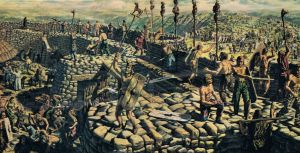 subjected.
subjected.
All this led the latter to defend themselves with a system of primitive fortifications, (the so-called "Castellari") placed on the tops of the mountains and coastal 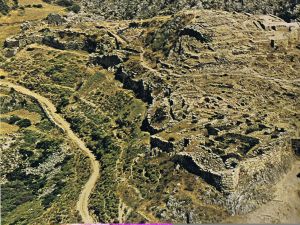 hills, very often steep and rocky on one or more sides, built with stones collected on the spot, forming dry-stone walls of various sizes and thickness, visually connected to each other. Inside these walls there were also watchtowers that provided protection to everything around them, roads, pastures and more. Some of the castle keepers were so big that inside there could also be an inhabited centre. Others, smaller, in case of danger would have welcomed and protected the population outside, at least until the danger had passed.
hills, very often steep and rocky on one or more sides, built with stones collected on the spot, forming dry-stone walls of various sizes and thickness, visually connected to each other. Inside these walls there were also watchtowers that provided protection to everything around them, roads, pastures and more. Some of the castle keepers were so big that inside there could also be an inhabited centre. Others, smaller, in case of danger would have welcomed and protected the population outside, at least until the danger had passed.
Although they are present in almost all of Liguria and also in the Pre-Alpine arc from the Aosta Valley to the Julian Karst, proving to be culturally widespread, in the Riviera di Ponente, thanks to archaeological research, many traces of these castellari have been found. Most of them date back to the 4th century B.C. and lasted until Roman times, generally circular or oval, but they could also be quadrangular, protected by one or more walls.
Along the whole belt of mountains surrounding Sanremo, there is a defensive system based on these "castellari". Without going into details that are of particular interest to archaeology, we will indicate the most salient points affected by this system. 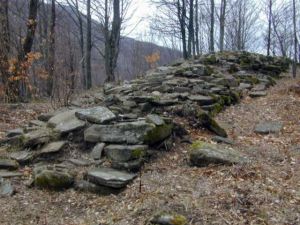 As said before, these fortifications were in visual contact with each other so that in view of the castellar of cima Merello, above Bordighera, just a little above Capo Nero, on the Mucchio di Scaglie mountain, as the name itself says, there are piles of stones of a castellar or of a collapsed watchtower.
As said before, these fortifications were in visual contact with each other so that in view of the castellar of cima Merello, above Bordighera, just a little above Capo Nero, on the Mucchio di Scaglie mountain, as the name itself says, there are piles of stones of a castellar or of a collapsed watchtower.
The next one could have been placed above Coldirodi, on the rocky relief of the Cross of Father Poggi but for which the interest was aroused only by a few ceramic fragments.
More certain traces can instead be found higher up, on Costa Bevino, south of Monte Caggio. In the middle of the bush there are some imposing walls so wide that they probably contain an entire inhabited centre and still to be explored.  We then arrive at Monte Caggio, the western fulcrum of the system, the top of which has the shape of a truncated cone and from which a square dry-stone building with a base partly formed by large, very thick walls emerges. It is not known exactly how it is used, but from its shape, which can also be seen in the nearby Monte Bignone, one would say it is a castellaro. Near that peak, there were also some rocks and collapsed slabs, a sign that something important was there.
We then arrive at Monte Caggio, the western fulcrum of the system, the top of which has the shape of a truncated cone and from which a square dry-stone building with a base partly formed by large, very thick walls emerges. It is not known exactly how it is used, but from its shape, which can also be seen in the nearby Monte Bignone, one would say it is a castellaro. Near that peak, there were also some rocks and collapsed slabs, a sign that something important was there.
On the other hand, the archaeological interest of the place had already been pointed out by an ancient manuscript, which described the top of the mountain in 1642: « ...crowned with eight walls...all one on top of the other...the first of these walls rests with its foundations on a square...where you can see some stones worked by art and you can see some squared parts and there is one that forms a table, others scattered there form seats.... ».
The territory of Sanremo is also affected by a defensive system of castles and intermediate points, which runs along the belt of its mountains. A little above Capo Nero, at the western end and in visual connection with the great castellar of cima Merello near Bordighera, Mount Mucchio di Scaglie represents, as the toponym itself suggests, the pile of stones of a castellar or of a probable collapsed watchtower. In the bottom of the hut excavated by the Superintendence, pottery of the Republican age of the Campania type has been found, but in the areas surrounding the summit the fragments collected testify the frequentation of the place until the IV century A.D. There is also pottery of the pre-Roman type with impasto, although very rare.  The next point of connection, going up the ridge, could be situated at the rocky outcrop of the Croce di Padre Poggi, above Coldirodi, whose interest is documented by a few but significant ceramic fragments. To find safe traces you have to go up again and reach Costa Bevino, south of Monte Caggio. Hidden from the bush are imposing walls that seem to delimit a large rectangular enclosure, perhaps the defensive area of a village to be explored, although so far there is no confirmation of archaeological nature.
The next point of connection, going up the ridge, could be situated at the rocky outcrop of the Croce di Padre Poggi, above Coldirodi, whose interest is documented by a few but significant ceramic fragments. To find safe traces you have to go up again and reach Costa Bevino, south of Monte Caggio. Hidden from the bush are imposing walls that seem to delimit a large rectangular enclosure, perhaps the defensive area of a village to be explored, although so far there is no confirmation of archaeological nature.
We are now underneath the wall of Monte Bignone (1298 m), on the summit of which the highest castle of the region has been identified and partly excavated, placed to clearly defend the surrounding pastures. A double wall with a base resting on the rock and formed by earthy accumulations defended it on the northern side, while on the other sides the rocky and precipitous nature ensured its entrepreneurship. The internal area, now occupied by the cistern of the public aqueduct and a tourist belvedere, has returned two square buildings with dry masonry, between 1.40 and 2.05 m thick, with internal rooms of about 6 x 6 m, the size already ascertained on Mount Caggio (perhaps a construction module of the time), without doors and windows. Traces of a fireplace were found on the floor of one of the rooms.
The archaeological materials collected include fragments of pre-Roman ceramics of local manufacture and amphorae with micaceous impasto of the Massaliot type, dated to the 5th 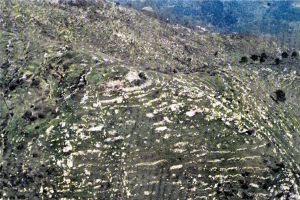 century BC. The surface still to be excavated, spared by modern constructions, should preserve other walled remains of the type brought to light.
century BC. The surface still to be excavated, spared by modern constructions, should preserve other walled remains of the type brought to light.
From the summit of Mount Bignone, following and descending along the eastern ridge of the belt, you reach the castellaro of Mount Colma (649 m), overlooking the village of Verezzo. It is the most important and probably, at the present state of research, the most complete castellaro of the far west of Liguria, with polygonal walls. On the most exposed sides, to the north and to the south, the walls, formed by a double parallel cordon filled with rough minute stones, reach a considerable thickness of nine metres; the other two sides, raised on natural roughness of the ground, are only one metre thick. The height of the belts has been estimated at about three metres, while its overall development exceeds one hundred metres.
 The internal area includes the remains of a square building, the ruins of a probable tower and a flat area to the south, of unknown use. Some small pre-Roman and Roman dry-stone buildings of modest size are leaning against the outer walls, a sign that two distinct villages were settled in different ages by shepherds and farmers in the area, which today has the thick weave of terraces abandoned after the war. A Roman age box clearly appears to have been destroyed by fire, an event that perhaps led to the abandonment of the site. Among the recovered pottery fragments, very abundant and dated from the 5th century B.C. to the 3rd century A.D., there are also parts of Massaliote amphorae, already found upstream Bignone (and also present in the pre-Roman layers of the city of Albintimilium or
The internal area includes the remains of a square building, the ruins of a probable tower and a flat area to the south, of unknown use. Some small pre-Roman and Roman dry-stone buildings of modest size are leaning against the outer walls, a sign that two distinct villages were settled in different ages by shepherds and farmers in the area, which today has the thick weave of terraces abandoned after the war. A Roman age box clearly appears to have been destroyed by fire, an event that perhaps led to the abandonment of the site. Among the recovered pottery fragments, very abundant and dated from the 5th century B.C. to the 3rd century A.D., there are also parts of Massaliote amphorae, already found upstream Bignone (and also present in the pre-Roman layers of the city of Albintimilium or 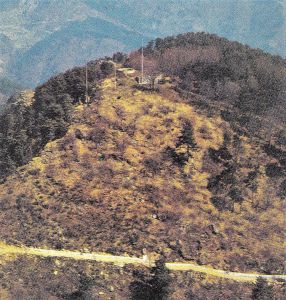 Ventimiglia). Once again the problem of contacts with the Greek colony of Marseille is proposed; but supplies could be made through local intermediaries, or they could be the result of piracy.
Ventimiglia). Once again the problem of contacts with the Greek colony of Marseille is proposed; but supplies could be made through local intermediaries, or they could be the result of piracy.
The belt of the Sanremo mountains is closed to the east by Cape Verde, preceded along the ridge by the summit of Mount Cavo and the hill on which the sanctuary of the Madonna della Guardia stands. It is obvious to think that in those parts there was the last ring of the defensive system of the pre-Roman Sanremesi, but the intense and repeated use of the land for floriculture must have erased all traces of it. It should be noted, however, that to date neither masonry structures nor sporadic materials have come to light.
Nino Lamboglia, the greatest historian of western Liguria, wrote: « Faced with the oppidas, embryos of the city, the castellaro is the primordial cell of the Ligurian organisation, around which all the life and unity of the tribe has developed, regulated by the needs of the soil and the economy ». 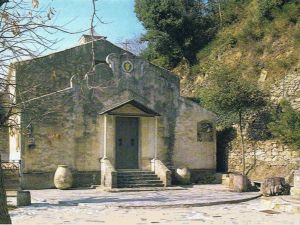 Today we know that also the human communities settled on the mountains and hills of San Remo were part of this reality; and that therefore they also contributed to the civil advancement of the society of their time.
Today we know that also the human communities settled on the mountains and hills of San Remo were part of this reality; and that therefore they also contributed to the civil advancement of the society of their time.
The last report of probable proto-historical relevance is a boulder engraved by a series of five cups joined by a small canal near the hermitage of San Michele, on the southern slopes of Mount Bignone. The boulder, of rounded and elongated shape, is flanked by the mule track that leads to the ancient monastery, and is therefore perhaps the signalling of a sacred place since the centuries that preceded the foundation of the church. This enigmatic type of rock carving, however, known in other areas of Liguria and the Alps, cannot easily be assigned to a certain period and therefore lends itself to more than one interpretation, not excluding protohistoric origins.
(sources: free elaboration from the Book “Sanremo, cuore e anima di una Città" by Enzo Bernardini; ed. Istituto Geografico de Agostini-1987; images from private archives)
Next 2nd part




